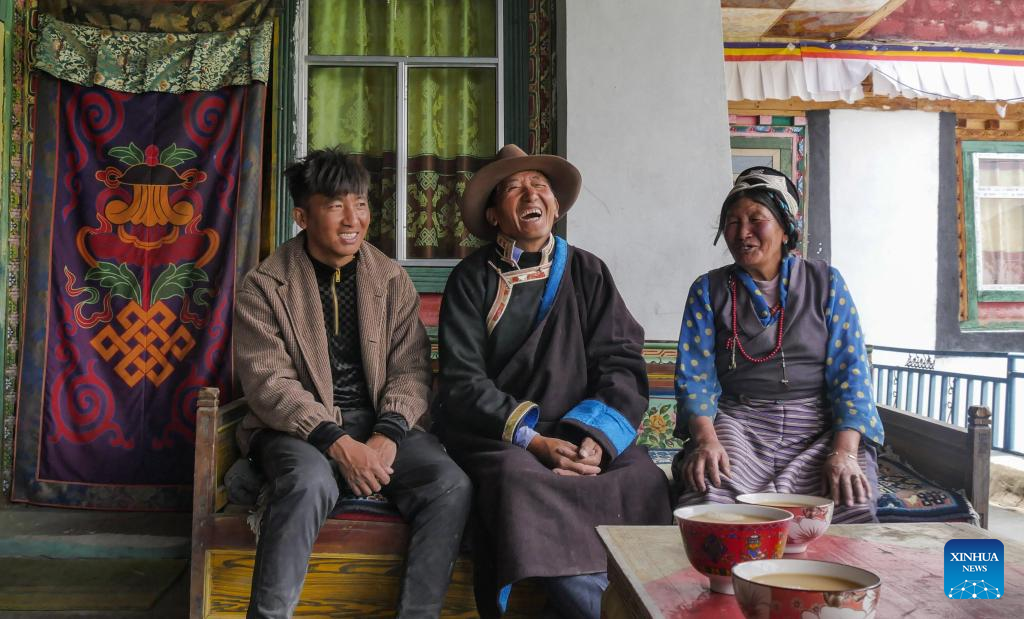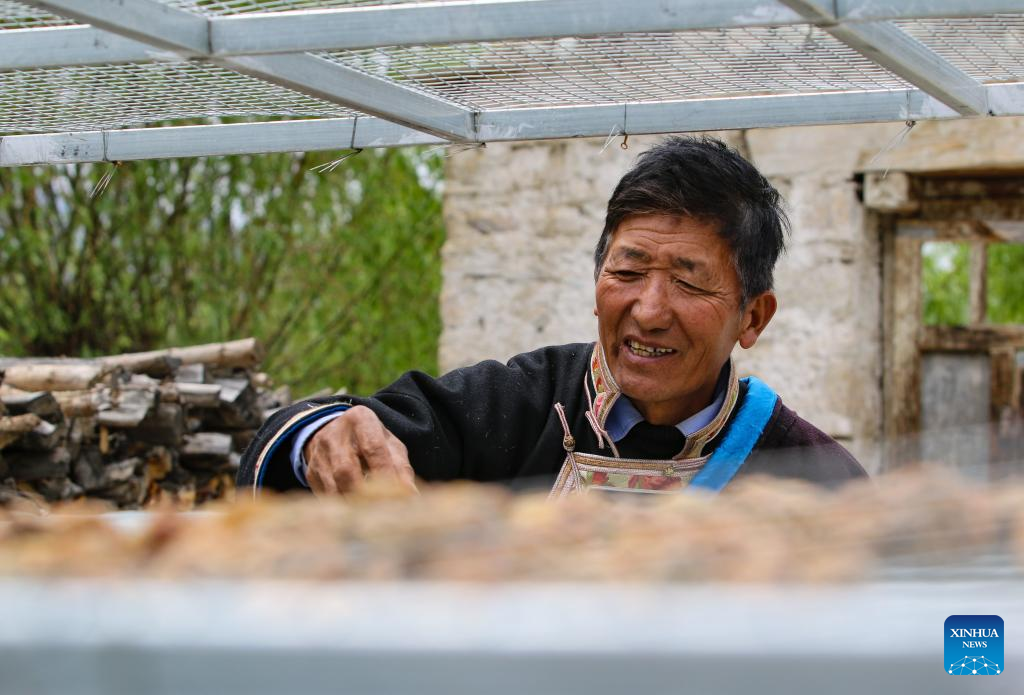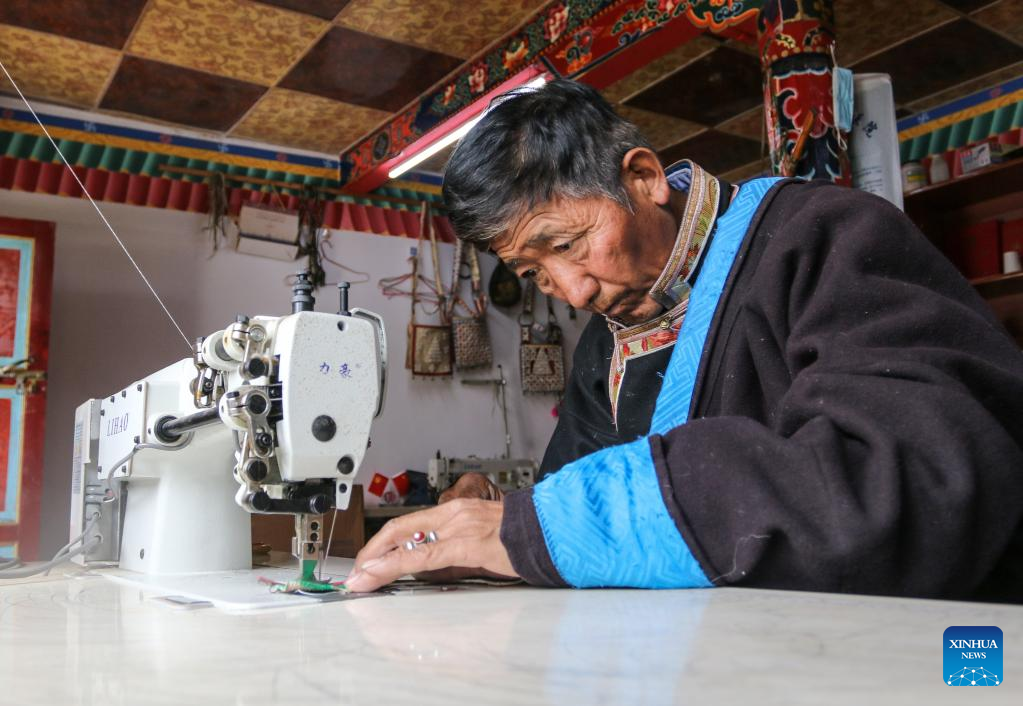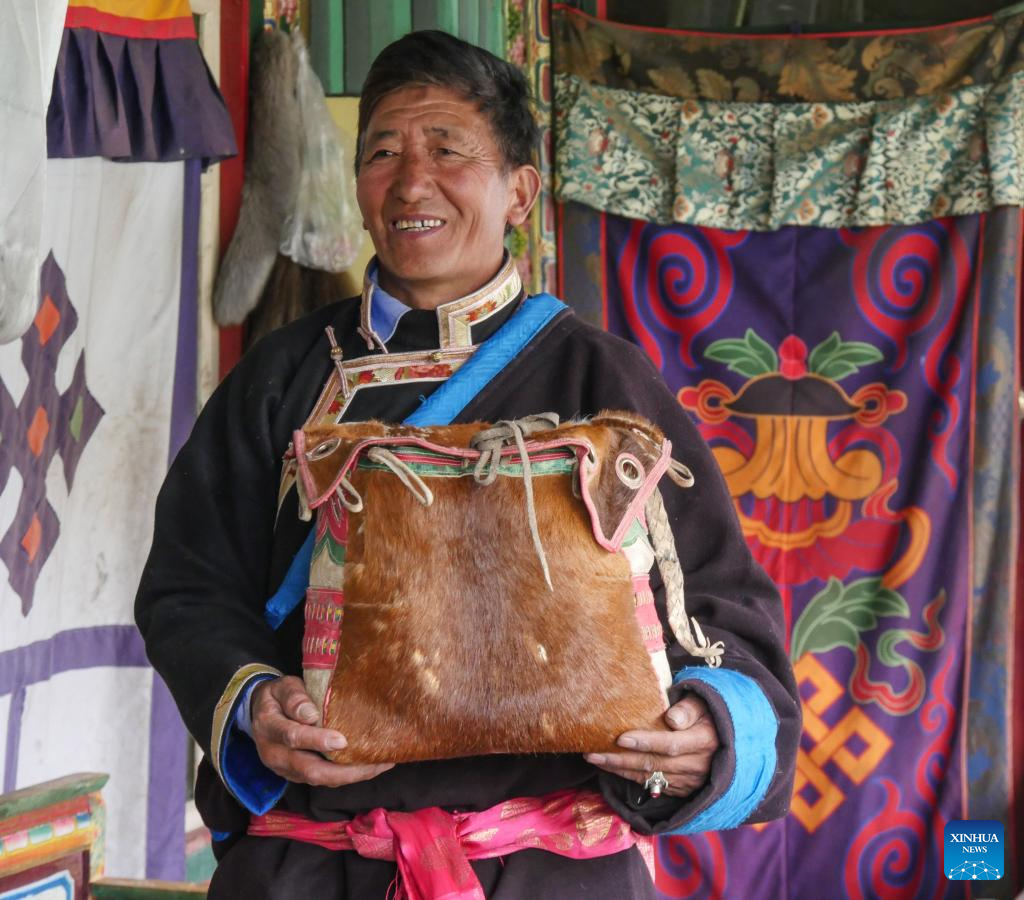
Sonam Chophel (C) is pictured with his family in Thomai Village of Nyingchi City, southwest China's Tibet Autonomous Region, April 19, 2023. (Xinhua/Liu Zhoupeng)
LHASA, June 9 (Xinhua) -- Step through the Tibetan-style curtain, and you will find Sonam Chophel's studio, featuring traditional Tibetan saddlebags of different colors, designs and sizes.
The 61-year-old craftsman has been making these fine objects since his youth, continuing a tradition that is deeply embedded in the local culture, and that has just about survived despite the pressures of the modern world.
Saddlemaking of this sort is a form of local intangible cultural heritage in this part of southwest China's Tibet Autonomous Region. In recent decades, it reached the brink of extinction, but now the local authorities are working hard to preserve it.
Sonam Chophel's impressive "saddlebag kingdom" is located at his home in Thomai Village, Nang County, in Tibet's city of Nyingchi. The bags vary in size from large ones made of dark-brown leather that require two hands to hold, to the smallest, which are the size of one's palm. These carefully crafted objects are mostly made of cow hide, with antelope fur trim, and are decorated with traditional patterns, such as auspicious clouds.
Dating back more than 300 years, the craft of making the bags by hand was acknowledged in 2018 as a form of regional intangible cultural heritage. In the past, the people of Tibet relied on horses and yaks to travel around, and waterproof and portable saddlebags with a large capacity were a matter of necessity. They allowed a range of objects to be carried on a journey, while spreading the load comfortably on the horses' back and flanks.
"I still remember the awe-inspiring sight I saw in my village when I was a child: adults carrying big, beautiful saddlebags on horses," Sonam Chophel said. "It made me dream about making the bags. At the age of 21, I began to learn the craft from a senior craftsman."
Sonam Chophel was among the first official inheritors of this local intangible cultural heritage, and now practices his craft with pride. However, a decade ago, this traditional craft was on the point of disappearing forever.
At that time, due to the rapid development of road traffic, expressways mushroomed and brought in large numbers of vehicles, with horse riding restricted to areas of pasture land. People seemed to no longer need saddlebags, according to Sonam Chophel.
The complicated production procedures are so time-consuming that a pair of saddlebags takes about a week to finish.
The raw materials, such as cow hide, need to be soaked in water, with the flesh scraped off and the skin fully rubbed. "It takes at least three days to get the perfect hide through rubbing. When it is cold, my hands easily become red and numb due to the hard work," the craftsman said.
With the passage of time, fewer and fewer youngsters in Tibet were willing to learn the dying craft as Sonam Chophel did.
In 2015, Thomai Village established a local project to preserve the craft of making traditional saddlebags. The village received about 450,000 yuan (about 64,000 U.S. dollars) in funding to build and renovate workshops, purchase raw materials and enrich the existing products, thus forming a complete industrial chain, said Tsering Dondrup, director of the federation of trade unions in Nang County.
"Now we have all kinds of saddlebags in our factory," said Sonam Chophel. "Big ones are usually sold to herdsmen living in Tibet's pasture areas, while small ones are preferred by tourists and local residents as decorations or collectables," he said, adding that the biggest saddlebags can fetch up to 2,000 yuan.
Agjam Wangmo, a 40-year-old resident in Lhasa, the regional capital, bought a pair of palm-sized saddlebags, worth 300 yuan in total, during her trip to the county. "I like these delicate handicrafts. Allowing the craftsmen to make some money from their crafts is my way of showing my respect for them," she explained.
For Sonam Chophel, it is also a reward for his perseverance. "I'm glad that I didn't quit during those long years, so the craft can continue to be passed down through the generations," he said. ■

Sonam Chophel air-dries peach slices in Thomai Village of Nyingchi City, southwest China's Tibet Autonomous Region, April 19, 2023. (Xinhua/Nie Yi)

Sonam Chophel makes saddlebag in Thomai Village of Nyingchi City, southwest China's Tibet Autonomous Region, April 19, 2023. (Xinhua/Nie Yi)

Sonam Chophel demonstrates a saddlebag he made in Thomai Village of Nyingchi City, southwest China's Tibet Autonomous Region, April 19, 2023. (Xinhua/Liu Zhoupeng)



